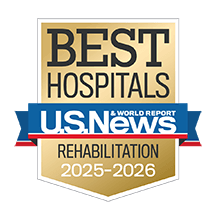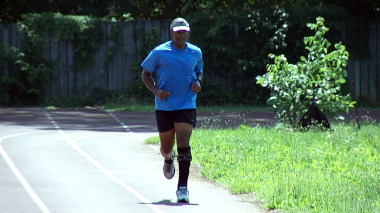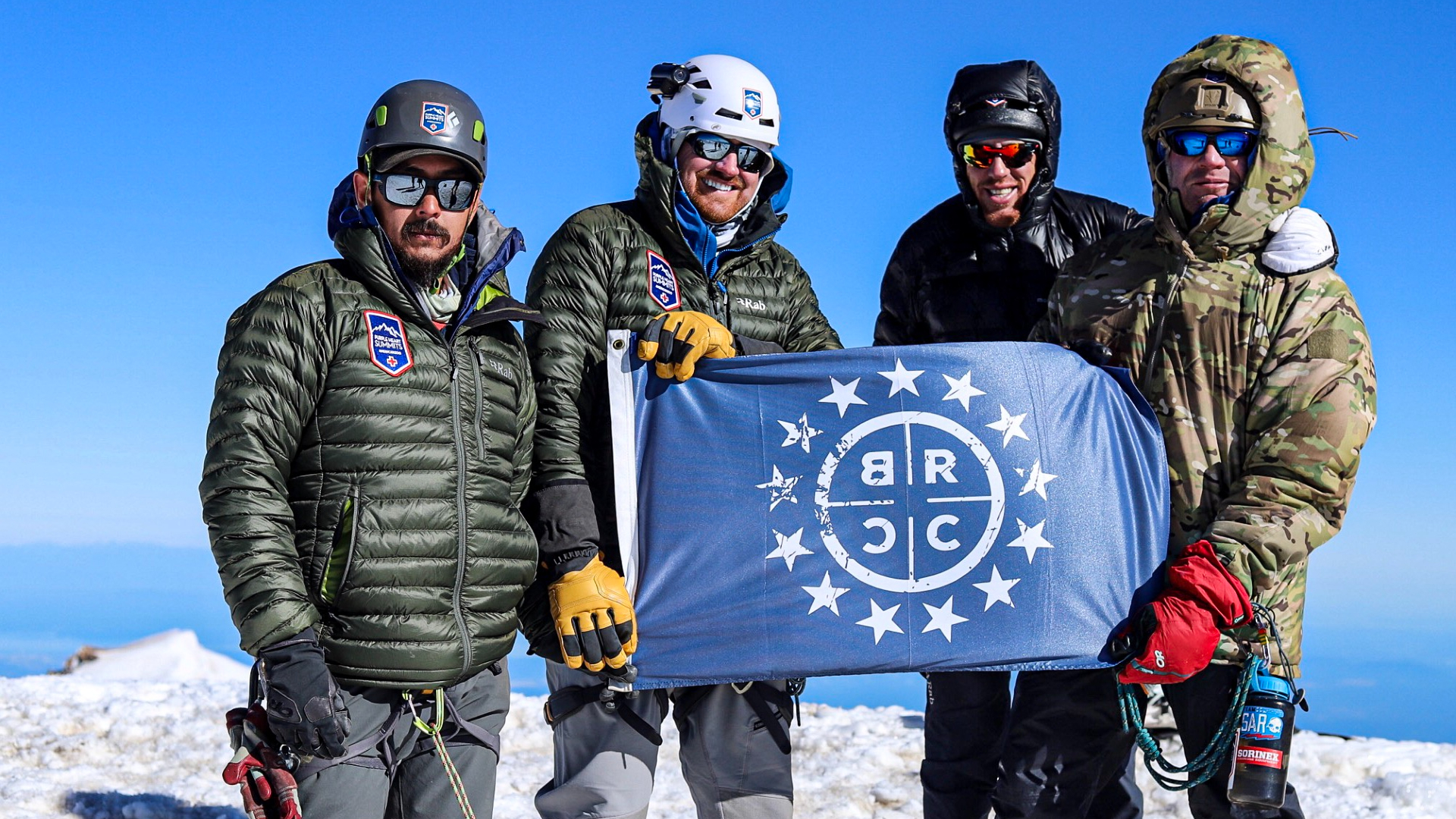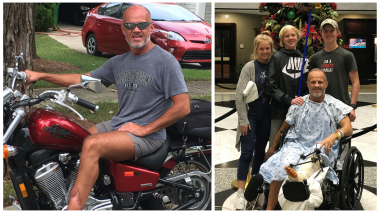Return to Performance Pathway Program

If you’re struggling to get back to daily living after a severe foot or ankle injury, the Return to Performance Pathway Program can give you a clear path to recovery in under 6 weeks. The program at Atrium Health Carolinas Rehabilitation combines physical therapy and a custom orthosis (state-of-the-art bracing). Our approach can help patients overcome serious lower limb injuries, and it’s so effective that some patients decide not to go through with amputation.
Atrium Health Carolinas Rehabilitation is proud to be named a Best Rehabilitation Hospital, ranking in the top 15 nationally and best in the Southeast by U.S. News & World Report.
Patient Care – What to Expect
The Return to Performance Pathway Program is a 4-to-6-week rehabilitation that is based on the Return to Run program that was developed and tested by the military. The Return to Performance Pathway Program was designed by a team of surgeons, physical therapists and orthotists at Atrium Health, Carolinas Rehabilitation and the Hanger Clinic. Our patients benefit from:
- The latest therapies: We use advanced, creative and diverse physical therapy and a custom fit orthosis to help you return to the activities you love.
- Research-driven approach: We’re leading research to transform the way we treat lower limb injuries. Many patients participate in our studies and take pride in helping us shape the next generation of innovative treatments. Learn more about our Clinical Research.
- Customized care: We’ll partner with you to understand your rehabilitation goals – whether it’s running a 5K or chasing your grandkids around the yard. Then we’ll tailor a treatment plan to help you achieve those goals.
- Team approach: Our team of physical therapists work with surgeons, orthotists and researchers to give you the best possible care. If you live outside of North and South Carolina, we also have a Global Healthcare Services team able to assist you with your visit. This team helps coordinate your medical treatment, appointments, travel logistics and all other arrangements to make your care as easy and convenient as possible.

Hilda Rides On
Hilda wouldn’t let a serious injury stop her from living her best life. Learn about her rehabilitation journey and see how we helped her get back to work as a spin instructor.
Hilda Rides OnWhat We Treat
We most commonly work with patients who have experienced traumatic lower leg, ankle and foot fractures. We also support people with the following conditions:
- Moderate to severe ankle arthritis
- Post-surgical club foot
- Prior surgeries to save a foot or lower leg after trauma that have resulted in pain and limited activity during recovery
- Continued foot and ankle pain with inability to reach the desired level of recovery and activity, despite trying other bracing
Explore our orthopedic and sports medicine offerings at Atrium Health Musculoskeletal Institute.
Return to Performance Pathway Program Overview
We work to maximize your movement and ability using a custom orthosis. Once you have your orthosis, we’ll use physical therapy to help you achieve your physical activity goals.
Custom Brace (Variable Cadence Orthosis)
Certified orthotists create a custom device, built to meet your exact needs. This device helps patients increase their comfort and abilities during movement, creating a new option for people who had previously considered amputation due to poor function and pain. This style of orthosis has enriched the lives of hundreds of people by helping them return to a more active lifestyle.
Physical Therapy
You’ll need to wear this orthosis anytime you want to enhance your performance while you’re moving (it’s not a temporary correction for an injury, like wearing a boot). We’re here to help you feel confident and comfortable wearing it. We focus on each client as an individual with unique abilities and distinct goals. Our team of experts works together to help you achieve your goals.
Get to Know Our Lead Physical Therapist
Tarey Strickland has worked as a physical therapist for over 25 years, of which over 20 have been at Atrium Health. Before coming here, she built a multidisciplinary lower extremity (leg and foot) wound care program within the VA (Veterans Health Administration) system to help decrease amputation risk.
Now, as the lead physical therapist at the Return to Performance Pathway Program, Tarey has created a pathway to enhance mobility and quality of life for patients with various lower leg conditions. This work involves using a custom brace (the Variable Cadence Orthosis) to hold the foot and ankle in a specific position to help patients recover lost capabilities.
Tarey works closely with Joseph Hsu, MD, Director, Limb Lengthening and Deformity Service, orthotists and researchers to deliver patient-empowered results. Her expertise in Variable Cadence Orthosis rehabilitation is a vital asset to the program, and her unwavering dedication to her clients helps enrich the lives of everyone she works with.
Frequently Asked Question About the Variable Cadence Orthosis
The Variable Cadence Orthosis has a solid foot plate with a narrow metal bar, called a strut, coming from the heel area. The strut goes up the back of the calf, connecting to a shell (cuff) that goes around the upper part of the calf. The shell at the top of the calf opens with a special pop lock, which gives the foot and ankle room to slide in or out when putting the brace on or taking it off. The brace comes in assorted colors, and fabric can even be used in some designs.

The Variable Cadence Orthosis footplate is custom made to fit each wearer. The brace maker takes a mold of the foot and ankle in a position that results in the least amount of pain. The proper stiffness of the strut is selected for each patient based on the specific activity level desired and body weight.
Then, the strut is attached to a custom upper shell. The relationship of the strut and its connections at the bottom and top of the brace help displace forces of movement away from the foot/ankle and lower leg to the upper part of the lower leg. When the foot strikes the ground, one’s pain is minimized by having the perfect ankle-and-foot position.
As the foot rolls through a walking motion on a solid, custom-made footplate, the strut in the back "bows" and helps the foot lift off the ground into the swing phase. The foot and ankle no longer have to do all the work of pushing into or lifting off the ground: The brace takes over!
People with various conditions who haven’t been able to return to their normal activities because of pain and loss of joint motion can benefit from the VCO. Here are some common reasons people use the VCO:
- Ankle arthritis
- Broken lower leg, ankle or foot (or any combination of the 3) with continued pain during movement (often caused by a traumatic accident)
- Club foot
- Prior surgeries to save a foot or lower leg after trauma that have resulted in pain and limited activity during recovery
A certified orthotist or certified prosthetist-orthotist makes the brace. If you do your own research to find a brace maker, make sure to call and ask if they’re able to make a Variable Cadence Orthosis (sometimes referred to as a FabTech or ExoSym).
Typically, the orthotist or orthotist-prosthetist will take your history, watch you walk and ask questions about your activity goals. A mold will be taken of your foot and upper leg. This mold will be made into a tester brace for you to try out. A final brace will be made if the tester is a good fit and provides improved performance and optimal pain control.
No, most likely your normal shoes will not be big enough for this brace. A wider and longer shoe is often required to wear this type of orthosis. Often people will buy 2 different size shoes. Some stores allow the purchase of a split shoe size (one shoe size for the uninjured foot and a larger shoe size for the brace foot). People will sometimes wear a larger shoe on their normal foot so they can buy just one pair of matching shoes. Sandals and high heels will not work with this brace. Your orthotist can provide shoe and work boot recommendations, especially as shoes and models change yearly.
The cost varies for every person, based on insurance coverage and the brace maker’s fees. Insurance companies typically do not cover the cost of shoes.
It’s also helpful to wear a below-knee compression sock on the device leg. Some insurance companies may cover compression socks.
The footplate on the brace is solid and the strut is very stiff, so ankle movement is severely restricted. Therefore, driving with the brace is not recommended.
It depends. Some people do not need physical therapy to return to their activities once the device fits well and their shoes are appropriately sized. Some people need a physical therapist's expertise to help them return to their normal activities and hobbies.
Seek out a physical therapist if you have:
- Trouble moving onto and “rolling through” the footplate of the brace
- Excessive pain when placing pressure onto the foot and ankle during weight-bearing activities
- Trouble performing an activity that’s important to living your best life
Ask your orthotist for a physical therapist recommendation. They should know one who’s trained to work with the Variable Cadence Orthosis.
See pictures: abdominal work, glute work, weighted pushing, balance activities, stretching, isotonic strengthening, and dynamic movement.







Pros may include:
- Improving your abilities to do your work
- Moving with less pain while doing household chores
- Doing community service activities without needing to sit frequently
- Keeping up with kids or grandkids
Cons may include:
- Wearing wider and longer shoes
- Not being able to wear sandals or high heels
- Not being able to drive with the brace on
- Not being able to wear skinny jeans or tight pants and hide the brace underneath (brace will be worn above the pants such as these styles)
For Hilda, the pros outweighed the cons. See her story.
Call 980-402-1970 and ask for an evaluation with a physical therapist in the Return to Performance Program. Referrals are not required for nonhospital-based clinics.
Atrium Health Global Health team is available to assist folks traveling from outside South Carolina or North Carolina. Contact us at 704-446-7028 or AtriumHealth.org/Global.





